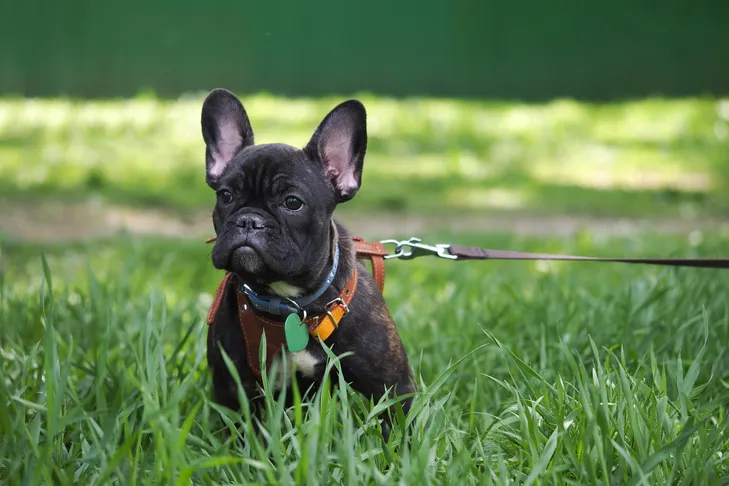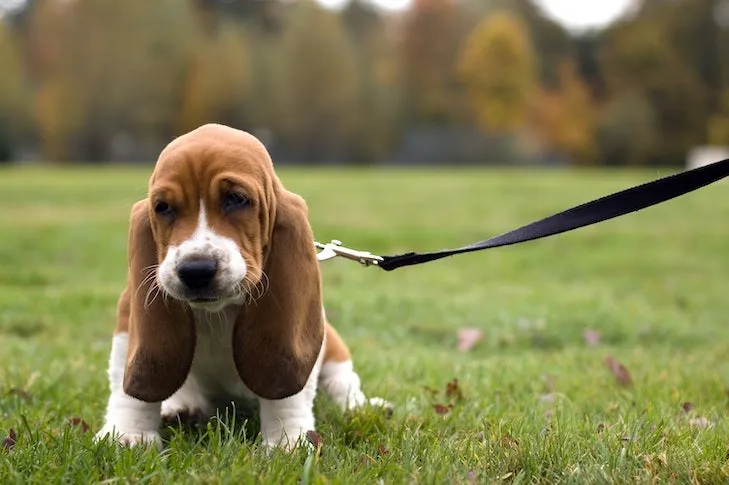Many new dog owners assume that puppies instinctively know how to walk politely on a leash. However, teaching a puppy to walk on a leash is a fundamental skill that requires patient and consistent training. Mastering this skill is incredibly rewarding, making every outing with your furry companion a pleasant experience. To help you on this journey, we’ve compiled essential Tips For Training A Puppy To Walk On A Leash, drawing on expert advice from renowned dog training expert and AKC Family Dog columnist, Kathy Santo. These foundational techniques will help your puppy develop good leash manners from an early age, ensuring safe and enjoyable walks for years to come. Getting started early is key; if you’re wondering when to start leash training a dog, the answer is typically as soon as they are comfortable with a collar and leash.
Laying the Foundation: Essential Puppy Leash Training Steps
Establishing a strong foundation is crucial for successful leash training. Follow these steps to introduce your puppy to the leash and build positive associations.
Get Them Acclimated to Gear
The first step in teaching your puppy to walk on a leash is to help them feel comfortable wearing their gear. Begin by introducing a lightweight collar or a well-fitting harness and a leash. Allow your puppy to wear them for short durations inside the house during playtime or when offering treats. The aim is for your puppy to associate their collar and leash with positive experiences, making “leash time” synonymous with fun and rewards.
Introduce a Positive Reinforcement Cue
Next, establish a clear sound cue that signals an incoming reward. Many trainers utilize a clicker, while others prefer a verbal marker like “yes” or a simple tongue cluck. The method remains consistent: in a quiet, low-distraction environment, with your puppy wearing their collar and leash, make your chosen sound cue. The instant your puppy acknowledges you – by turning their head or making eye contact – immediately follow with a treat. With repetition, your puppy will not only look at you but actively approach you for their reward, anticipating the treat every time they hear the cue.
 A cute French Bulldog puppy wearing a harness and leash, sitting patiently in green grass during leash training.
A cute French Bulldog puppy wearing a harness and leash, sitting patiently in green grass during leash training.
Encourage Coming Towards You
Building on the cue, practice encouraging your puppy to move towards you. While they are on their way, and still wearing the leash and collar, take a few steps backward. Reward them generously with a treat and praise when they reach you. Gradually increase the distance, always rewarding when they successfully follow. Continue this progression until your puppy consistently comes to you and walks alongside you for several paces upon hearing the cue. Remember, puppies have short attention spans. Keep training sessions brief and engaging, always ending on a positive note before your puppy becomes tired or frustrated. This early training also sets the stage for learning first tricks to teach a dog, as it builds a strong bond and responsiveness.
Practice Leash Walking Indoors
Once your puppy reliably comes to you, it’s time to practice short walks in a low-distraction indoor environment. The feeling and sight of the leash will be a new sensation and challenge in itself. Continue to use your positive reinforcement cue and reward system. Offer treats and verbal praise as your puppy learns to walk with you while the leash is attached, understanding that staying close to you brings good things. This indoor practice is vital for building confidence before venturing outside.
Transition to Outdoor Leash Walking
Now, your puppy is ready to experience the world outside. This step introduces a new level of complexity due to the myriad of captivating sights, sounds, and smells. Patience is paramount here, and initial outdoor walks should be kept very short. Maintain constant awareness of your puppy’s behavior. If you notice them about to lunge towards something or become overly distracted, use your established cue and take a few steps away from the distraction. Reward them immediately when they follow you, reinforcing that focusing on you is more rewarding than chasing distractions.
 A Basset Hound puppy calmly sitting on a leash outdoors, practicing good leash walking behavior.
A Basset Hound puppy calmly sitting on a leash outdoors, practicing good leash walking behavior.
Troubleshooting Common Leash-Training Challenges
Even with a solid foundation in place, puppies (and adult dogs) can encounter new challenges as they mature, explore different environments, and face novel distractions. The goal is to teach your puppy to walk on a loose leash, which is not only more enjoyable for both of you but also a key skill for advanced obedience training, like the Canine Good Citizen test. The AKC GoodDog! Helpline offers valuable insights for resolving these common leash-training issues.
When Your Puppy Pulls on the Leash
Pulling on the leash is one of the most common and frustrating behaviors. If your puppy starts pulling ahead or in a different direction, immediately stop and become “a tree.” Stand perfectly still and refuse to move until the tension on the leash slackens, and your puppy returns their attention to you. Avoid yanking, jerking, or dragging your puppy. Consistency is key here. For persistent pullers, specialized tools like front-hook harnesses or head halters can be highly effective in teaching them how to stop a puppy from pulling. These tools offer better control and discourage pulling without causing discomfort. If you’re struggling to how to get dog to quit pulling on leash, remember that consistent training and the right equipment can make a significant difference.
Addressing Puppy Lunging
Lunging at other dogs, cars, or people is a challenging behavior that requires proactive management. The moment you anticipate your puppy is about to lunge – perhaps by noticing their body language or a sudden interest in a target – immediately use your cue and redirect their attention with a high-value treat. Increase the physical distance between your puppy and the object of their fixation. Always stay alert and be prepared to intervene before they have a chance to lunge. While this behavior might be more prevalent in certain breeds like herding dogs, any puppy can be startled or overstimulated. Mastering how to keep dogs from pulling when walking often involves addressing the root causes of lunging and reactivity.
Managing Excessive Barking on Leash
Some puppies develop a habit of barking excessively at other dogs or people during walks. Often, this behavior stems from insufficient mental and physical exercise. Ensure your puppy receives an appropriate amount of stimulation for their age and breed. If barking persists, employ a similar strategy to lunging: create distance from the trigger and offer treats before the barking starts. The goal is to teach your puppy to turn their attention to you upon seeing another dog, associating it with a positive reward rather than an opportunity to bark. Over time, this consistent redirection will help your puppy learn to calmly observe their surroundings.
Maintaining Good Leash Behavior and Seeking Further Help
Gradually, as your puppy matures and gains experience, you’ll find yourself relying less on constant treats and troubleshooting during walks. However, it’s always a good practice to keep some treats on hand for random positive reinforcement of desired leash-walking behavior. Consistency and patience are your most powerful tools in shaping a well-behaved walking companion.
Training your puppy to walk politely on a leash is an investment in a harmonious future together. While these tips for training a puppy to walk on a leash provide a strong foundation, remember that every puppy is unique. If you encounter persistent challenges or require more personalized guidance, don’t hesitate to seek professional assistance. Services like the AKC GoodDog! Helpline connect you with experienced trainers who can offer individualized advice on everything from basic manners to complex behavioral issues, ensuring you and your puppy enjoy many happy walks together.
